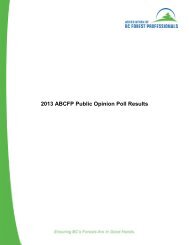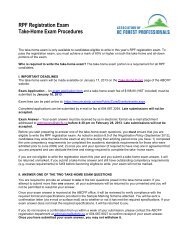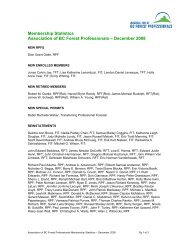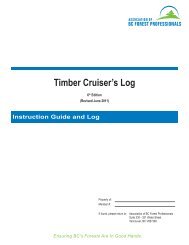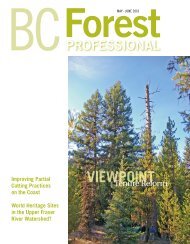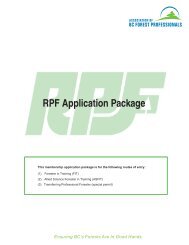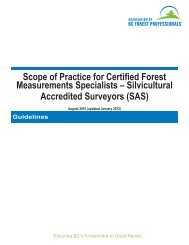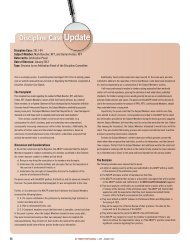VIEWPOINT - Association of BC Forest Professionals
VIEWPOINT - Association of BC Forest Professionals
VIEWPOINT - Association of BC Forest Professionals
You also want an ePaper? Increase the reach of your titles
YUMPU automatically turns print PDFs into web optimized ePapers that Google loves.
FuEL MANAgEMENT Continued from Page 14<br />
Book Review<br />
<strong>Forest</strong> Life: British Columbia Woodlots<br />
fire management? Are there any shortcomings in the current legislation?<br />
From the perspective <strong>of</strong> wildfire management branch the Wildfire<br />
Act and Regulation has been a great advancement in standardizing all<br />
aspects <strong>of</strong> wildfire management. Many <strong>of</strong> the challenges associated<br />
with wildfire management do not arise out <strong>of</strong> issues with the legislation.<br />
They arise out <strong>of</strong> a lack <strong>of</strong> understanding <strong>of</strong> the requirement for proactive<br />
wildfire prevention on the part <strong>of</strong> communities, commercial operations<br />
(especially non-forestry operations) and the public in general.<br />
Overall has the provincial government’s response to the wildfire and forest<br />
fire management issue been appropriate given the issues that have been<br />
identified?<br />
Yes. It has taken decades to create the fuel management challenges<br />
we now face. This challenge will not be solved quickly. It will<br />
take cooperation, planning and funding to keep up and enhance<br />
the momentum. These challenges will not be resolved by one party<br />
alone but through the concerted efforts and participation <strong>of</strong> homeowners,<br />
all levels <strong>of</strong> government, industry, and First Nations.<br />
While there has been progress in reducing wildfire risks in interface<br />
areas many opportunities still exist. The provincial fuels management<br />
22 <strong>BC</strong> FOREST PROFESSIONAL | MARCH - ApRil 2010<br />
Wim Tewinkel<br />
Federation <strong>of</strong> <strong>BC</strong> Woodlot <strong>Association</strong>, 2009<br />
200pp, illustr.<br />
ISBN 9780981265704<br />
Part <strong>of</strong> the foreword says it all: “Through photographs and a<br />
few words, this book attempts to capture the seasonal beauty <strong>of</strong> coastal<br />
and interior woodlots as well as the spirit and culture <strong>of</strong> woodlotters and<br />
their families.”<br />
The author has succeeded very well in this attempt: abundant,<br />
splendid illustrations depict the scope and variety <strong>of</strong> <strong>BC</strong>’s forests. Scenes<br />
<strong>of</strong> woodlot activity show the wide range <strong>of</strong> practices required to realise<br />
all the many management opportunities in a woodlot and thumbnail<br />
sketches tell something <strong>of</strong> the self-reliant operators who dedicate their<br />
lives to thoughtful, sustainable management <strong>of</strong> their forest holdings.<br />
I was surprised not to find mention <strong>of</strong> two notables in the gallery<br />
<strong>of</strong> woodlot owners—Merv Wilkinson and Tom Wright—and wonder at<br />
their omission. My only other criticism is the caption above a picture<br />
<strong>of</strong> burned trees which will mislead an uncritical reader. It says, “A<br />
forest destroyed by fire.”<br />
Ranking: 4.5 out <strong>of</strong> 5 cones<br />
When only a stand <strong>of</strong> trees<br />
has been ‘destroyed,’ the<br />
forest remains in being.<br />
This is a handsome<br />
and valuable addition to<br />
<strong>BC</strong>’s forest literature. 3<br />
Reviewed by<br />
Roy Strang, RPF, (Ret)<br />
working group is taking proactive steps at addressing wildfire risks:<br />
• The MFR Fuel Management Program has been accelerated<br />
• The Union <strong>of</strong> British Columbia Municipalities has been coordinating<br />
funding and communications for CWPPs with its members<br />
• The First Nations Emergency Services Society and forest fuels<br />
management working group <strong>of</strong> the First Nations <strong>Forest</strong>ry Council<br />
have been very active in working directly with First Nations<br />
communities to address wildfire risks.<br />
One area <strong>of</strong> opportunity for the A<strong>BC</strong>FP and its members is to provide<br />
leadership for the development and implementation <strong>of</strong> CWPPs. Our<br />
members are well-placed to contribute, as private land owners, volunteers<br />
or representing the provincial government, the MFR, forest and<br />
other tenure holders, municipalities or Aboriginal communities. 3<br />
Jackie Hipwell, RFT is resource associate for pr<strong>of</strong>essional practice and<br />
forest stewardship with the A<strong>BC</strong>FP. Her forestry background includes a<br />
diploma from the Northern Alberta Institute <strong>of</strong> Technology and varied<br />
forestry employment with government, consultants and industry.<br />
This article was prepared in consultation with staff from the Ministry <strong>of</strong> <strong>Forest</strong>s and Range wildfire<br />
management branch, who also provided the photos.



